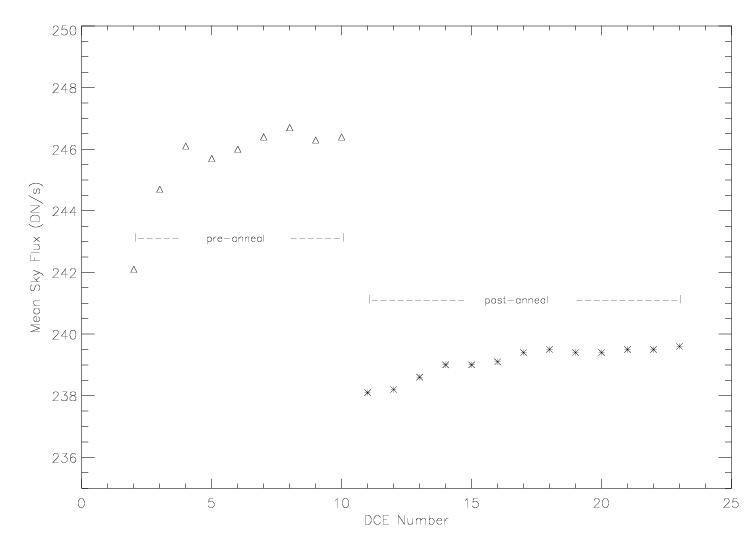
Principal:
Deputy:
Analyst:
AORKEYS:
Last Updated:
We converted the diagnostic data from the thermal anneal into temperatures and generated temperature plots. These data are compared to the temperature curves from previous anneals. These data are presented in the metatask writeup mips-2050.
We compared the 24um SUR data taken before and after the thermal anneal to look for changes in array behavior. The item of interest is the detector responsivity.
A Vrst analysis was performed on the Vrst data. In this test, the bias voltages for the 70um and 160um arrays are set to 0 mV, and then the Vrst voltages are adjusted between +5 mV and -5 mV relative to normal. A bright stim is turned on in manual mode during the test. The principle is that the array will produce a strong positive slope when positively biased and a strong negative slope when negatively biased, so the zero bias voltage point can be easily recognized. In practice, we calculate slope images and then look for this transition point.
filenames: mips_IER_7784704_gen_0_A24_Pukn_3s.fits
mips_IER_7784704_gen_(3-15)_A24_Pukn_10s.fits
DCE FrameMean FrameMedian
2 242.1 +/- 49.58 241.2
3 244.7 +/- 51.01 243.8
4 246.1 +/- 50.99 245.7
5 245.7 +/- 48.98 245.
6 246. +/- 49.7 245.6
7 246.4 +/- 49.43 245.6
8 246.7 +/- 51.5 245.7
9 246.3 +/- 49.05 245.6
10 246.4 +/- 49.15 246.3
--- Thermal Anneal happened here ---
2 238.1 +/- 24.98 239.3
4 238.2 +/- 24.81 239.1
6 238.6 +/- 25.44 239.3
8 239. +/- 25.72 239.6
10 239. +/- 25.58 239.9
12 239.1 +/- 25.56 239.9
14 239.4 +/- 26.25 239.7
16 239.5 +/- 26.81 240.2
18 239.4 +/- 25.45 240.3
20 239.4 +/- 25.73 240.4
22 239.5 +/- 25.79 239.8
24 239.5 +/- 25.23 240.5
26 239.6 +/- 25.55 240.2
The median sky fluxes are plotted below:

As mentioned in previous mips-992 writeups, the proper reference for the post-anneal data is the first data point from the pre-anneal data, which is the first DCE after a bias boost DCE. In this 49-hour long campaign, the growth in Si detector response due to cosmic ray exposure is 1.0%.
The Vrst data are presented below. The filenames are MIPS_IER_7784704_gen_*_A70/A160_Pukn_10s.fits. I analyzed the data using SIRTFSEE, so I used the first DCE in each pair of observations for this analysis, whereas I used the 2nd DCE in all previous analyses. I ignored the first frame and the last 72 frames in the 70um Vrst slope calculations. I ignored the last 76 frames in the 160 Vrst slope calculations. This campaign is the first one in which we had real Ge anneals, which is another difference that might be partially responsible for the noticeably different Vrst values that were determined below.
File Bias 70_1 70_2 70_3 70_4 70_5 70_6 70_7 70_8 160_1 160_2 160_3 160_4 03 Nom 80 -110 10 -60 -60 -40 40 -150 92 -80 17 28 04 +5 -85 -135 -115 -180 -150 -160 -85 -165 -897 -689 -372 -232 05 +4 -50 -65 -80 -135 -120 -130 -65 -130 -697 -479 -244 -125 06 +3 -35 -20 -55 -90 -90 -110 -65 -110 -389 -332 -141 -74 07 +2 -20 10 -40 -70 -90 -105 -70 -100 -130 -202 -60 -13 08 +1 0 35 -30 -50 -70 -80 -60 -80 84 -107 8 20 09 Nom 20 60 -10 -40 -60 -70 -50 -70 319 -22 82 62 10 -1 30 85 10 -20 -65 -60 -55 -75 568 67 160 122 11 -2 50 110 25 10 -50 -50 -40 -60 820 154 249 179 12 -3 85 150 40 0 -40 -40 -40 -40 1099 256 354 264 13 -4 100 170 100 30 -20 -25 -30 -50 1425 372 482 355 14 -5 100 170 80 50 -15 -10 -20 -40 1820 490 602 460 15 Nom -30 -50 -45 -95 -90 -120 -90 -120 167 -22 79 78 Vrst +1.0 +2.5 -0.5 -2.0 -6.0 -5.75 -7.0 -7.0 +0.75 -0.25 +1.0 +1.5 DAC Counts +4 +10 -2 -8 -24 -23 -28 -28 +3 -1 4 +6 DAC NOM 90E 8F7 910 8E7 916 90B 920 905 97D 91C 91C 913 New DAC 912 901 90E 8DF 8FE 8F4 904 8E9 980 91B 920 919